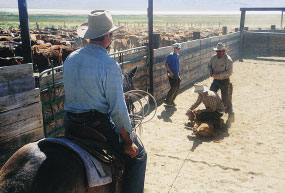Go West, Young Man
Expecting something somewhere between CBS’ Survivor: the Sierra Nevada and the PBS series Frontier House 1900, where a family must live without the conveniences of modern-day life, I agreed to spend a month at Deep Springs College, located in a remote desert valley east of the Sierra Nevada Mountains in California. My boyfriend had attended this extraordinary liberal arts college and was returning to teach for the spring term in 2002. By extension, I would be welcomed into this self-sustaining intellectual and agricultural community.
Deep Springs is not nearly as well known as it should be, given that it is one of the most selective colleges in the country. It is an entirely free, two-year college for men, where the student to faculty ratio is 4 to 1. Designed as preparation for a life of service and leadership, it was started in 1917 by electrical engineering maverick L.L. Nunn. He believed leaders should have experience in community building, manual labor, and rigorous academics; he also required public speaking and composition.

Spring round-up event at Deep Springs College where young calfs are branded and inoculated.
Deep Springs’ president, a dean, and 26 undergraduates (who make up the entire student body) act together as the college administration, sharing responsibility for everything from hiring the faculty and selecting the next year’s class to conducting peer evaluations. In addition, they operate a certified organic farm and cattle ranch, and maintain all the campus buildings and machinery. While women are not students, there are female faculty members and staff members, and families are an essential part of the experience. Students give faculty kids music and art lessons, and teach them poetry and soccer, as well.
Life at the college is demanding. Undergraduates (who, incidentally, must have top SAT scores) operate heavy equipment, like tractors and backhoes, milk cows, cook for the community, and spend evenings discussing Heidegger and the rest of the Western Canon. They must serve on committees that focus on budget, admissions, and faculty recruitment issues. Meanwhile, they also apply to other institutions, to finish their undergraduate education. (Most transfer to Harvard, Yale, University of Chicago, Swarthmore, or Cornell.)
At Deep Springs’ isolated location on the California/Nevada border, intense concentration can hardly be avoided; in this valley you are removed from everything else in the world. Telephone service is dependent upon the winds of the desert. There is no cell service, and the Internet connection is so bad as to hardly be worth having. Newspapers arrive days late, the mail comes from Nevada, and the closest town (Bishop, California) is about 45 miles away — through a very narrow mountain pass.
Yet it is exactly because it is so isolated and small that you somehow get swept up in being a part of the Deep Springs community. I felt I was expected to take part in the labor, so I bucked hay, butchered meat, mowed lawns, and made soap from the lard of a recently slaughtered cow. Not only did students come to our house to go over their economics assignments, but they also joined us at every meal in the community dining center. And when professors and students work side by side to build walls or fix a solar heating system, everyone seems to understand it’s for the good of all.
As for the single-sex aspect of Deep Springs, the coeducation debate has been, and will continue to be, a lively one. Students recognize they are giving up something by attending a single-sex institution; but for at least a year or two, they’re putting selfless service and academics first. The current thinking among the students is that women should have their own Deep Springs. They have developed a plan for a sister school. A women’s college with a farm? Seems everything old can be born new again.
Diane Asadorian ’80 is a freelance writer and television producer in Cambridge, MA.
Photo by Will Masters
